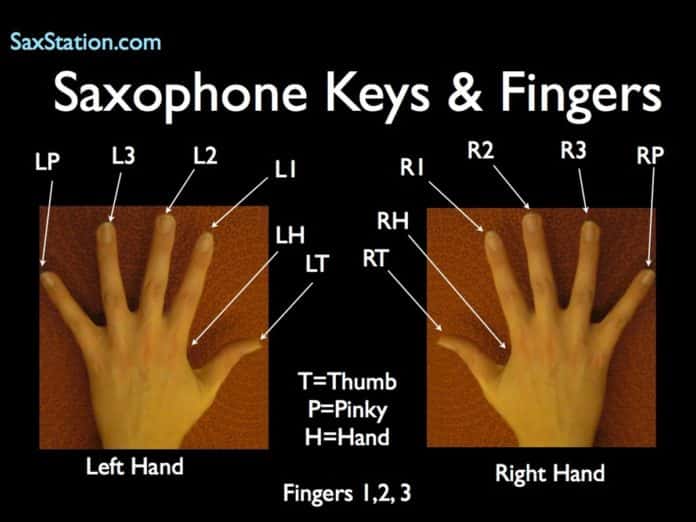
If you are a beginner saxophone player, a sax fingering chart can be confusing.
In this article, we will break down how to use the alto saxophone fingering chart. You will also see how the different elements of the fingering chart can be applied to the saxophone.
The Importance of Saxophone Fingering Charts
Saxophone fingering charts are an important reference tool for all saxophone players. Learning fingering charts is essential whether you are using a baritone, tenor saxophone, alto saxophone, or soprano saxophone.
For beginners, the number of keys on the sax might be confusing at first, but a great fingering chart can help you get through the first few notes.
As you play the saxophone, the finger chart will be a reference guide for notes that you don’t use very often, like some trill saxophone fingerings—mainly notes you are uncertain of.
For intermediate and advanced sax players, the saxophone fingering chart will serve as a reminder of those uncomfortable altissimo fingers or all the notes in the fourth octave that might be tough to get your fingers around and feel unfamiliar.
How to Read Sax Fingering Charts
Each of the odd shapes on the saxophone fingering chart corresponds to a saxophone key.
To make it simple, if one of these shapes is filled in, you’re pressing that key. If it’s hollow, you’re not pressing it down.
You only have to identify the matching keys on your saxophone for each of those shapes. If they’re filled in, you place your finger there.
Left-Hand Notes and Fingerings
On your left side, you’ll see that an alto saxophone has a round, black, or gold button on the back. You must keep your thumb on the back button.
After that, there should be four spherical keys visible on the front of your saxophone. You could have a fifth key up there. It usually looks like a spatula key, although it may be a rounder key on earlier saxophones.
A little round key is also there but concentrate on the three bigger round keys. On the finger chart, the top three circles symbolise these keys.
To play the saxophone with these basic notes, use these three keys:
● B denotes the first key pressed
● A denotes the first two keys
● G stands for the first three keys
Right-Hand Notes and Fingerings
A small hook for your thumb is at the back of your saxophone. This is only a guide to show you where your hand should go because your neck strap handles all the hard lifting.
Every saxophone has three spherical keys in front. These keys are accessed with your right index, middle, and ring fingers—with the index finger on the first, middle finger on the second, and ring finger on the third. The bottom three circular keys on the saxophone fingering chart reflect these.
All three of your left keys must be pushed down before playing notes with these right-hand keys. You can play the following notes:
● F = Right Hand + first key
● E = Right Hand + first two keys
● D = Right Hand + first three keys
Extra Keys on the Saxophone
To advance the saxophone notes up an octave, press the huge flat key above your left-hand thumb resting on the back of your sax.
When your thumb is on the back of the saxophone, the heel of your hand should be on the button.
The octave key can thus be used with the tip of your thumb to make the movement as minimal and efficient as possible.
Other Left Side Keys
The side keys, commonly known as “Palm Keys,” are also located in the upper right corner of the fingering chart and are used with your left hand. Operate these by pressing in sideways with the thumb on the back button.
Other Right Side Keys
On the right side of the saxophone, your right-hand pinky finger controls two low note keys.
Remember that whenever you press down on these low notes, you must likewise press down on the other six keys.
Altissimo and Alternate Fingerings
The altissimo fingerings demonstrate how to play the notes in the fourth octave of the saxophone. Altissimo notes are more complex, and depending on your saxophone, you may discover that one fingering method works better than another.
Alternate saxophone fingerings are pretty beneficial for playing quicker, more fluid lines. Alternate fingerings are like a secret weapon when tackling those challenging, quick sections.
Alternate fingering for trill keys and an altissimo fingering chart up to 4th octave high F for right and left-hand users are included in our newly updated saxophone fingering chart!
Take a closer look and learn more about alternate fingerings for alto sax in this video.
How to Play The Saxophone With Faster Fingers
To practise your fingers on an alto or tenor saxophone, start by keeping them as near to the keys as possible at all times. They should constantly be touching the sax.
You may practise this by looking at your fingers in the mirror.
You can find more tips on practising your fingers to be faster by checking this faster finger workout.









